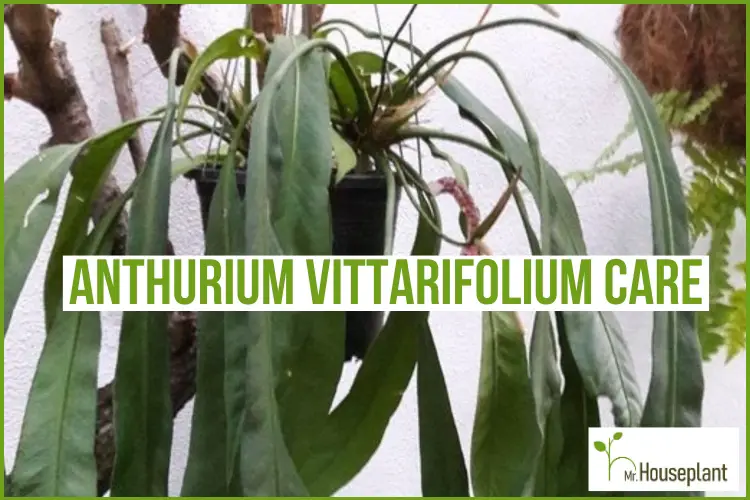
If you’re interested in proper Anthurium Vittarifolium care, you came to the right place. Keep reading for a complete plant care guide that will teach you everything about light, soil, watering, fertilizing, and anything else you need to know about this gorgeous plant!
| Botanical Name (Latin Name/Scientific Name): | Anthurium Vittariifolium |
| Common Name: | Anthurium Vittarifolium, Anthurium Vittariifolium |
| Light: | Bright indirect light (5,000+ lux; 500+ foot candles) |
| Watering: | once the top 2” of the soil are dry; never let the soil fully dry out |
| Soil: | Airy, chunky mix |
| Repotting: | Once a year |
| Temperature: | warm temperatures between 65°F and 86°F (18°C and 30°C) |
| Humidity: | Above 50% |
| Fertilizing: | Every 2 to 4 weeks with a high nitrogen fertilizer |
| Flowering: | Once it reaches maturity |
| Toxicity for Pets: | likely yes (dermatitis) |
| Toxicity for Humans: | yes |
| Propagation: |
|
| Pruning: | Prune dead or diseased growth or when you want the plant to branch out |
Anthurium Vittarifolium plant is a pendant anthurium, also called a strap leaf anthurium in the family Araceae (arum family). Pendant anthurium refers to anthuriums whose growth tip always grows downwards. This gorgeous plant hangs off of trees in its natural environment.
It’s native to South America, more specifically, to Amazonia tropical rainforests in Colombia, Peru and Brazil. It has long narrow leaves, green colored. It produces light green, creamish flowers that produce red berries.
The correct spelling of the name is Anthurium Vittariifolium, with double “i”, although most people spell it incorrectly with one “i” (Anthurium Vittarifolium).
Anthurium Vittarifolium Care
Anthurium Vittarifolium care is in general easy, as long as you provide the plant with an light over 5,000 lux, a chunky potting mix, frequent watering and humidity over 50%. Make sure to avoid overwatering and exposing the plant to a lot of direct sunlight as this can damage the leaves. This plant is also susceptible to certain pests and diseases, so keep an eye on possible aphid infestation and fungus gnats.
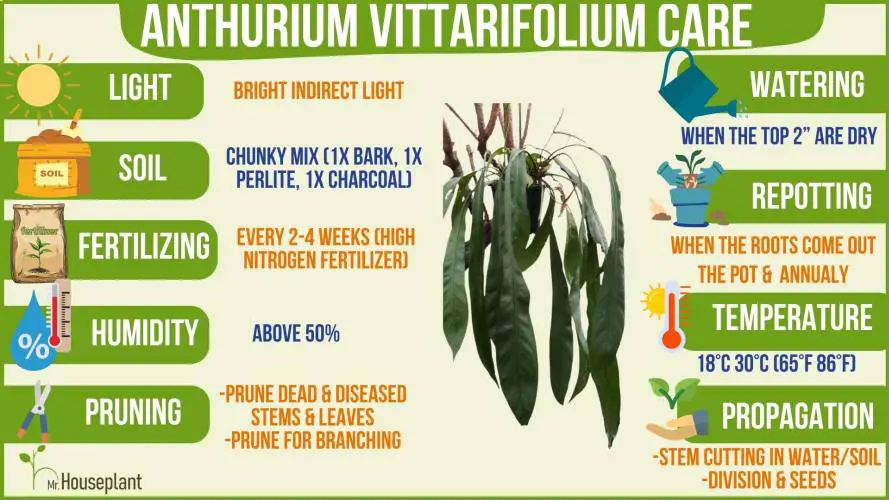
Follow these care requirements to grow a healthy Vittarifolium plant
Light Requirements
| Minimal amount of light: | 3,000 lux (300 FC) |
| Optimal amount of light: | 5,000+ lux (500+ FC) |
| Direct sun tolerance: | 1-2 hours |
| Category: | Bright indirect light |
The minimal amount of light recommended for Vittarifolium is 3,000 lux (300 foot candles), and the optimal amount of light is over 5,000 lux (500 FC). It can tolerate 1-2 hours of early morning direct sun, and if you want it to produce flowers you should aim for 6-8 hours of bright indirect sunlight daily.
A bit of direct sunlight is beneficial, as one hour of direct sun can replace tens of hours of indirect light. But make sure not to overdo it, since the leaves can get sunburned from too much direct sunlight.
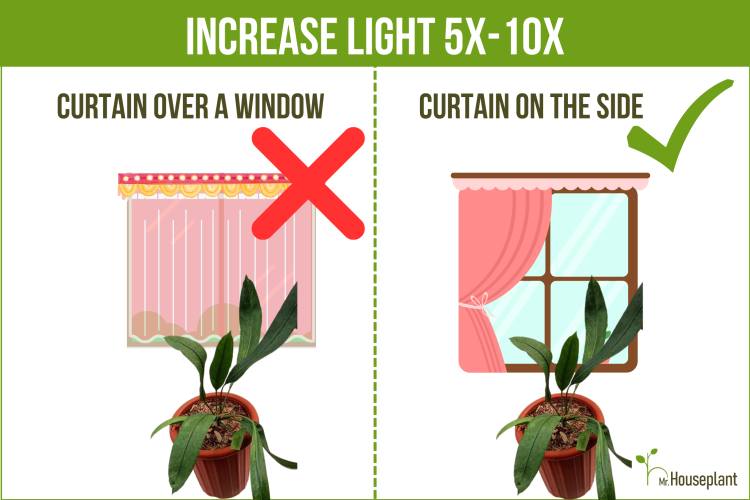
Move the curtain on the side of a window to increase light 5x-10x
Watering
The golden rule for Anthurium Vittarifolium watering frequency is to water it once the top 2” of the potting mix are dry. Insert a chopstick into the center of the pot, when you pull it out, if the top 2 inches are dry, it’s time to water.
It’s a thirsty plant, but watering shouldn’t follow a specific schedule, as houseplants require different watering frequencies depending on your home environment. It is important to avoid overwatering your plant, as it can lead to root rot and fungus gnats.
Make sure your pot has drainage holes so any excess water can drain out.
Soil
Anthurium will grow well in an airy, chunky potting mix, such as this one: 1 part orchid bark, 1 part perlite, 1 part charcoal. Using amendments with larger particles is vital because they create macro pores containing oxygen. Having an oxygen-rich potting mix lowers the chances of root rot and nutritional deficiencies.
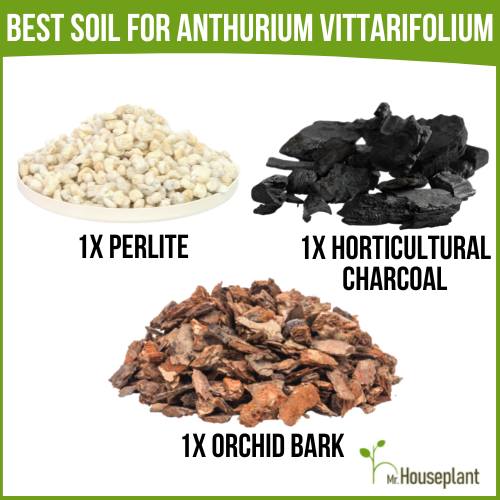
Orchid bark, perlite and horticultural charcoal make a perfect soil mix
Repotting
The steps to repot your Anthurium Vittarifolium are listed below:
- Use a container or a pot that is one size larger than the one you’re currently using
- Fill the pot one-third with fresh, well-draining soil mix
- Take out the plant from the pot and loosen the rootball
- Look at the roots and remove dead and rotting roots if you notice them
- Place your plant in the middle of the new pot
- Fill in the sides of the pot with soil mix
- Firmly press the potting soil and water it
- Make sure that your new pot has drainage holes since the plant does not like soggy soil. While it’s possible to grow it in a pot without holes, it’s not recommended for beginners.
Since Vittarifolium is a vigorous grower, you will need to repot it once a year, or when it has outgrown its pot. You will notice that your plant has outgrown the pot if you gently pull the entire plant out and see mostly intertwined roots and not much soil. You can also check if the roots are poking out of the bottom of the container. This is a sign that you should repot your plant.
Repotting is crucial for plant health because the old, oxygen-deprived, compacted soil is removed in this process. If you don’t repot it once a year, gradually the soil will become compacted and deficient in nutrients, and the roots will not be getting enough oxygen.
Here is a video of the Vittarifolium repotting:
Fertilizing
If you repot your Anthurium Vittarifolium as soon as it outgrows it’s pot, you don’t need to fertilize it. When you repot it, it will get new nutrients necessary for proper growth from the fresh soil. However, if you would like to fertilize this plant, you can do it every 2 to 4 weeks, with a high nitrogen fertilizer, such as the Sill fertilizer. Make sure to follow the instructions on the fertilizer packaging.
The best time to fertilize is while the plant is actively growing. In that way, the plant can put all the nutrients to good use. Using a houseplant fertilizer on your plants outside of their growing season can do more harm than good since they will not be able to use the nutrients and they will build up in the soil. This can cause fertilizer burn.
Temperature
The optimal temperature for Anthurium Vittarifolium are warm temperatures between 65°F and 86°F (18°C and 30°C).
Humidity
This plant grows naturally in high humidity, and if you can provide humidity over 50% your Anthurium Vittarifolium will be happy.
Toxicity To Pets
Anthurium Vittarifolium plant is likely toxic to cats and dogs. American Society For The Prevention Of Cruelty To Animals (ASPCA) lists plants from the same family Araceae as toxic to pets. If you have pets, make sure to keep them away from this plant, as they could get dermatitis.
Toxicity To Humans
Anthurium Vittarifolium plant is toxic to humans, according to the California Poison Control System (CPCS). This plant belongs to Araceae (arum family) which means that it contains oxalate crystals that can cause skin irritation and pain to the lips, mouth, and tongue, if ingested. It can also cause problems with breathing by causing swelling in the throat.
Pruning
There are several reasons to prune Anthurium Vittarifolium, which are listed below:
- If you want the plant to branch out, prune it, and it will branch out below the cut
- If it becomes too big for your liking
- If you notice dry, dead parts of leaves and stems
- if you notice any sick or diseased, which need to be removed to prevent the disease from spreading
Anthurium Vittarifolium Flower
After Anthurium vittarifolium reaches maturity, it can frequently produce inflorescences. An inflorescence consists of many small flowers. The Anthurium vittarifolium flower is self-pollinating. After the pollination, the plant will produce red berries which contain seeds that are easy to germinate.
To stimulate flower production, keep the plant in sufficient light, over 5,000 lux (500 foot candles).
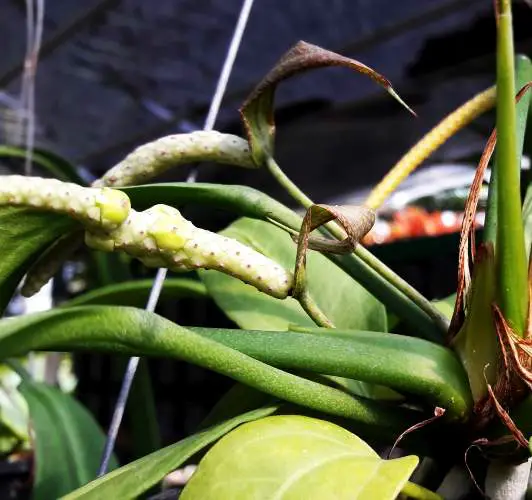
Vittarifolium flowering

Berries and flowers grow under the proper light
Anthurium Vittarifolium Propagation
To propagate Anthurium Vittarifolium you can use one of the four propagation methods listed below:
- stem cutting in water
- stem cutting in soil
- division
- seeds
The easiest and most popular method is propagation via stem cuttings in water. To propagate a plant using this method, you’ll need to:
- Take a few inches long stem cutting of a plant using scissors. Sterilize scissors and make a cut below a leaf node
- To increase chances of success, take several cuttings
- Place the cuttings into a container with fresh water, make sure that at least 2 nodes are in water and that the leaves are out of the water
- Make sure the cuttings get bright indirect light
- Replace the water once a week or as soon as it starts getting dirty
- Wait for new growth of roots
- In about 3-4 weeks the roots reach about an inch or two you can transfer the stem from water into a chunky soil mix
Check out the propagation video:
Common Problems
Root Rot
This plant is susceptible to rot when it’s overwatered, not receiving sufficient light and not grown in a chunky potting mix. The symptoms include yellow and wilting foliage. The roots will be soft, mushy and smelly. If this happens, cut off mushy roots, repot the plant into a chunky mix, and provide more light.
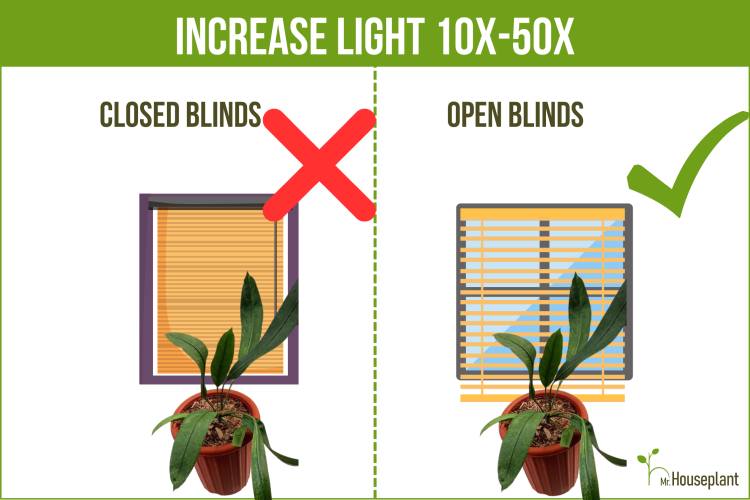
Lifting blinds will increase light by 10 to 50 times
Anthurium Vittarifolium Variegated
Anthurium Vittarifolium Variegated is a beautiful version of the plant. The variegated Anthurium Vittarifolium has yellow and light green blotches, like in the image below.
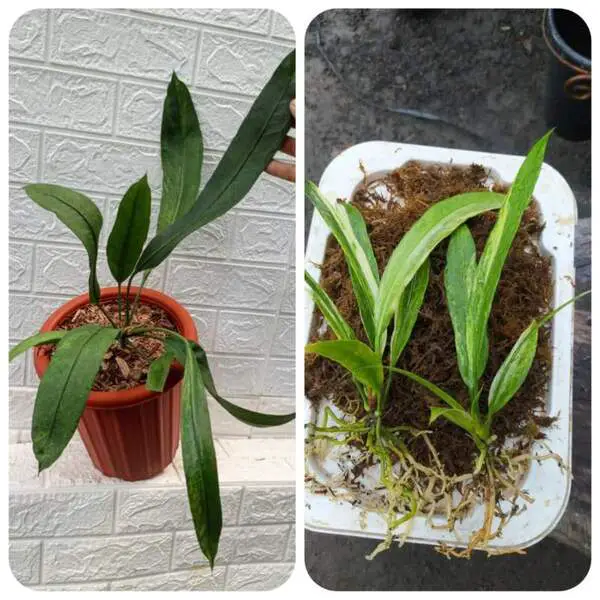
Anthurium Vittarifolium Variegated (Photo on the left by: Hendriana)
FAQs
Anthurium Vittarifolium vs. Anthurium Pallidiflorum
Here is how to tell the difference between Anthurium Vittarifolium and Anthurium Vittarifolium:
- The easiest way is to look at the leaf shape, specifically the base of the leaf, where it meets the petiole. The Vittarifolium has a pointed base while the Pallidiflorum is more rounded. For a detailed list of differences between Vittarifolium and Pallidiflorum, check out the linked blog post.
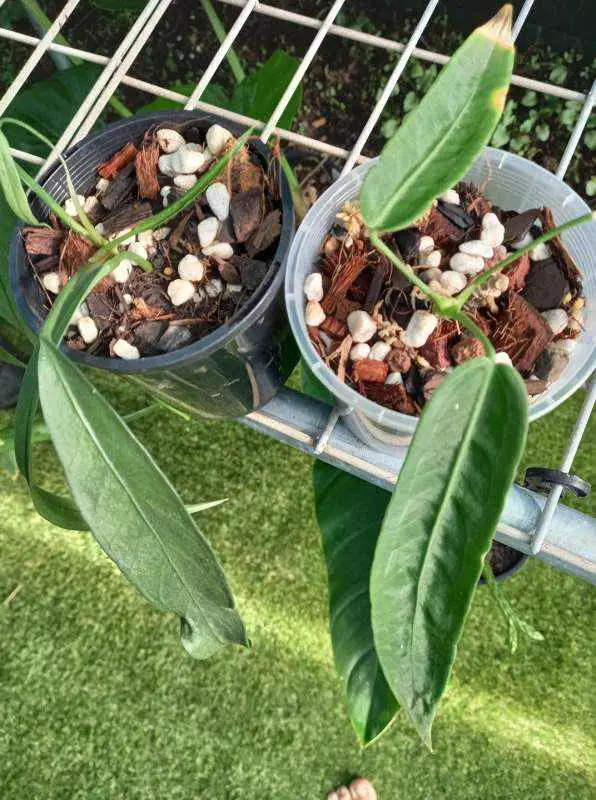
Vittarifolium on the left and Pallidiflorum on the right
Anthurium Bakeri vs Vittarifolium
The difference between the two species is that Anthurium Vittarifolium has a horizontal growth pattern, whereas Anthurium Bakeri grows vertically and foliage stands upright, as shown in the image below.
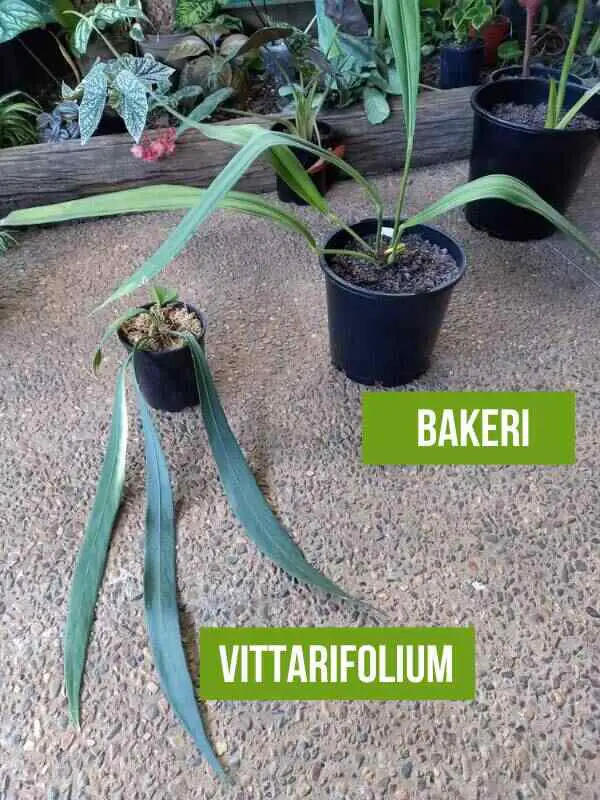
Vittarifolium on the left, growing horizontally, and Bakeri on the right, growing upwards (Photographer: Cory Duffy)
Is Anthurium Vittarifolium Rare?
Anthurium Vittarifolium is a rare plant endemic to South America. You can find it for purchase on Etsy or other online marketplaces. You can also find variegated version on Etsy.
Yours Truly,



Related Posts
Sansevieria Black Gold (Snake Plant Care GUIDE!)
Spathiphyllum Sensation (FULLY Explained!)
Alocasia Stingray Care